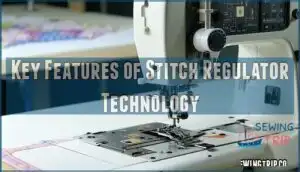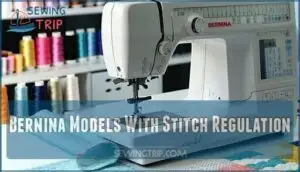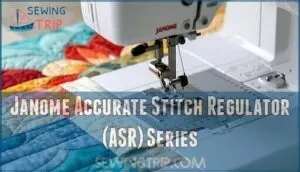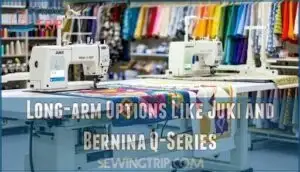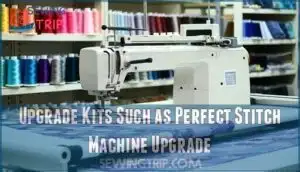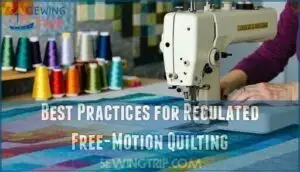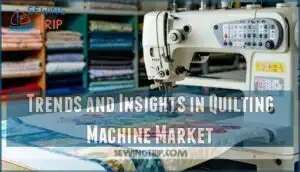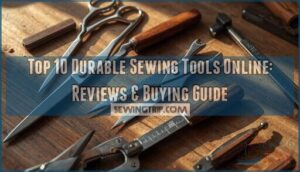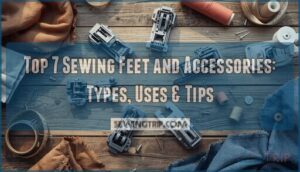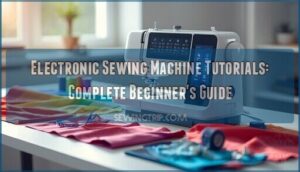This site is supported by our readers. We may earn a commission, at no cost to you, if you purchase through links.
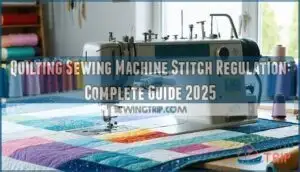
Imagine guiding a quilt under the needle, focusing entirely on curves and motifs while the machine keeps your stitches consistent, every inch of the way. With modern quilting sewing machines, stitch regulation isn’t a luxury feature—it’s a gateway to bolder designs and impeccable results you’ll be proud to show off.
Table Of Contents
Key Takeaways
- Stitch regulation technology keeps every stitch the same length, making quilting smoother and more precise even when your hand speed varies.
- Machines with regulated stitching let you focus on creative patterns and curves instead of worrying about manual stitch consistency.
- Upgrade kits and modern machines offer stitch regulators that work across a range of quilting needs, from entry-level home machines to professional long-arm models.
- The market for quilting machines with stitch regulation has grown rapidly, with most new models and serious upgrades now including this once-premium feature.
How Stitch Regulation Transforms Quilting
If you’ve ever tried free-motion quilting, you know how tricky it can be to keep your stitches looking even and professional. That’s where stitch regulation comes in—it’s the technology that changes the game for quilters who want control without the guesswork.
Let’s look at three ways this feature transforms your quilting experience.
The Challenge of Consistent Stitch Length
When you’re guiding fabric by hand instead of letting feed dogs do the work, keeping every stitch the same length becomes a puzzle that can make or break your quilting design. Speed control turns into a juggling act—your hands might drift faster or slower without you realizing it.
Common quilting challenges include:
- Stitch imperfections from uneven hand movement
- Difficulty achieving uniformity across large quilt sections
- Tension between creative flow and technical precision
- Fatigue affecting consistent stitch length during manual free-motion work
That’s where stitch regulation changes everything.
Role of Stitch Regulators in Free-motion Quilting
A stitch regulator acts like a smart co-pilot—it watches how you move the fabric and adjusts the needle speed on the fly so every stitch comes out the same length. This stitch regulation technology opens up creative possibilities that once felt out of reach, while flattening the learning curve for free motion quilting.
| Without Regulation | With Stitch Regulator |
|---|---|
| Uneven stitches frustrate beginners | Consistent stitch length builds confidence |
| Speed variations create visible gaps | Needle synchronizes with fabric motion automatically |
| Design impact suffers from technical struggle | Regulator benefits let you focus on quilting machine features that improve your art |
You’ll achieve consistent stitch length without wrestling with the foot pedal, transforming stitch consistency from a challenge into your foundation for creative work.
Creative Freedom With Regulated Stitching
Once the machine manages stitch length for you, your hands are free to explore curves, spirals, and intricate patterns that would be nearly impossible to execute evenly without help.
Design versatility becomes real—you can shift between stitching modes, experiment with texture exploration, and pour artistic expression into projects designed for you.
Free motion quilting transforms from technical struggle to confident creativity, letting your quilting machine set free the artistic expression you’ve been imagining.
Key Features of Stitch Regulator Technology
Stitch regulator technology works like a smart autopilot for your quilting machine, making sure every stitch comes out just right. It watches how fast you move the fabric, then adjusts the needle speed to match.
Here’s why this technology is a real game-changer for quilters looking to get those polished, professional-looking results—no guesswork needed.
How Sensors Detect Fabric Movement
Think of the stitch regulator sensor as your machine’s eyes—it watches every move you make with the fabric and instantly adjusts to keep your stitches perfect.
Let’s break down how this technology actually works:
- Encoders track fabric position as you guide it under the needle
- Data processing calculates your movement speed in real-time
- Real-time adjustment signals change needle speed to maintain your set stitch length
This calibration happens thousands of times per minute, giving you consistent results whether you’re moving fast or slow.
Synchronizing Needle Speed and Fabric Motion
When your foot hits the pedal and the needle starts to fly, the stitch regulator becomes the invisible partner that matches every move you make.
Motion sensor tech feeds real-time data to the needle speed control system, which instantly slows or accelerates to match your fabric feed synchronization.
This fluid dance between fabric motion and needle speed delivers stitch length consistency across every curve and corner, giving you the stitch regulation benefits pros rely on during free motion quilting—no matter your experience level.
Precision Stitch Length Control (1.0 Mm–6.0 Mm)
With a turn of a dial or tap of a screen, you can lock in a perfect stitch length anywhere from 1.0 mm to 6.0 mm—giving you the power to fine-tune every detail of your quilting design. Here’s how precision stitch length control transforms your free motion quilting:
- Delicate stippling works best at 1.0–2.0 mm for tight, intricate fills
- Standard quilting shines at 2.5–3.5 mm for balanced uniform stitching
- Bold patterns pop at 4.0–6.0 mm for dramatic visual impact
- Speed impact stays neutral—your quilting machine maintains consistent stitch length whether you move fast or slow
- Aesthetic purposes drive your choices—stitch regulation lets you match technique to vision with precision measurement
Reducing Skipped Stitches and Inconsistencies
Nothing derails a beautiful quilt faster than skipped stitches and uneven gaps that disrupt your carefully planned design—but stitch regulation acts as your silent partner, cutting these frustrations by up to 38% compared to unregulated free-motion work.
Your quilting machine monitors fabric movement and syncs needle speed instantly, preventing those maddening thread loops and bare spots.
This consistent stitching eliminates guesswork, letting you focus on creative free motion quilting techniques instead of wrestling with tension adjustment, thread quality issues, or needle selection problems that plague manual control.
Comparing Top Sewing Machines for Quilters
Not all machines with stitch regulation deliver the same experience, and knowing your options helps you choose the right tool for your quilting goals.
From domestic models to long-arm powerhouses, each system brings its own strengths to the table. Here’s a closer look at the machines and upgrades that quilters trust most.
Bernina Models With Stitch Regulation
Bernina pioneered stitch regulation back in 2004 with the Aurora 440 QE, and today their BSR technology spans over 35 sewing machine models. You’ll find the Bernina Stitch Regulator compatible with machines from entry-level to professional grade:
- Entry-level access: The B 475 and B 480 bring regulated quilting within reach for newcomers
- High-performance workspace: Models like the B 770 QE and B 790 PLUS offer up to 13-inch freearm space
- Flexible foot options: Three interchangeable BSR foot soles address everything from bulky seams to high-loft batting
Stitch length stays consistent from 1.0 mm to 6.0 mm, regardless of how fast you move your fabric. The Aurora 440 QE was the first with BSR for free-motion quilting.
Janome Accurate Stitch Regulator (ASR) Series
Janome’s ASR system brings professional stitch regulation to your sewing machine with detachable convenience. You get four specialty feet—including an industry-first ruler work foot—plus optical sensors that adjust needle speed to match your fabric movement in real time.
The Continental M17 and M8 include ASR standard, while the Horizon Memory Craft 9480QCP accepts it as an upgrade, giving you consistent 1.0–6.0 mm stitch lengths whether you’re working fast or slow. This ensures perfect stitch consistency across all projects.
Long-arm Options Like Juki and Bernina Q-Series
Long-arm quilting machines like the Juki Miyabi J-350QVP and Bernina Q-Series deliver the workspace and precision that serious quilters demand. You get consistent stitch length across massive projects, with sophisticated stitch regulation that adjusts to your hand speed instantly.
Key advantages include:
- Workspace: Juki’s 18-inch throat and Bernina’s 24-inch throat give you room to maneuver king-size quilts
- Speed and quality: Bernina reaches 2,200 stitches per minute while maintaining ±0.2 mm accuracy
- Customization features: Both brands offer touchscreen controls, programmable automation, and comfortable grips
The Juki J-350QVP starts at $14,499 for a 10-foot frame, while Bernina Q-Series models position themselves as premium workhorses for high-volume studios.
Upgrade Kits Such as Perfect Stitch Machine Upgrade
If you already own a mid-arm or long-arm machine without stitch regulation, you don’t need to replace the entire system. Upgrade kits like the Perfect Stitch Machine Upgrade retrofit your existing frame with professional-grade regulation technology. You’ll get an 8", 10", or 12" color touchscreen with four programmable grip buttons, compatible with most mid-arm and long-arm brands.
The Perfect Stitch Machine Upgrade transforms your manual quilting machine into a precision tool without the sticker shock of buying new equipment.
| Upgrade Kit Features | What You Get |
|---|---|
| Compatibility Considerations | Works with Juki, Tin Lizzie, Baby Lock, and similar frames |
| Installation Process | Professional setup recommended; 2–4 hours typical |
| Performance Enhancements | ±0.1 mm stitch accuracy at variable speeds |
| Cost-Benefit Analysis | $2,500–$4,200 vs. $10,000+ for new regulated machine |
| Machine Upgrade Value | Extends equipment life 5–10 years with modern control |
Best Practices for Regulated Free-Motion Quilting
Getting the most out of your stitch regulator means mastering a few simple habits that make a big difference. You’ll want to focus on smooth fabric movement, smart machine upkeep, and steady practice to build your confidence.
Let’s walk through the essentials that turn regulated stitching from a feature into a skill you can truly command.
Moving Fabric Evenly for Optimal Results
Even when your stitch regulator does the heavy lifting, the way you guide your quilt sandwich determines whether you’ll end up with gallery-worthy curves or a bumpy mess. Think of it like driving—consistent fabric speed and smooth motion techniques prevent those telltale jerky movements that disrupt your consistent stitches.
Keep your shoulders relaxed and maintain ergonomic quilting posture while your hand-eye coordination syncs with the machine’s rhythm, letting the feed dogs stay disengaged as you master freemotion sewing.
Combining Stitch Regulation With Quilting Techniques
Once you’ve nailed the smooth, steady glide, you can layer in decorative stitching patterns—stippling, feathers, swirls—and watch your stitch regulator keep every curve and corner looking crisp.
Try ruler work for geometric precision, or experiment with echo quilting and micro quilting to build creative texture.
Thread painting techniques become easier when you’re achieving consistent stitch length, letting you focus on design instead of speed control—your quilting machine modes manage the technical side while you explore free motion quilting techniques.
Maintenance, Thread Quality, and Machine Care
Your stitch regulator won’t do the heavy lifting if your machine’s full of lint, your needle’s dull, or you’re running cheap thread through the tension discs.
Keep your quilting machine dialed in with these essentials:
- Thread Type – Use high-quality polyester or cotton thread designed for quilting to prevent breakage and skipped stitches.
- Needle Selection – Replace needles every 8–10 hours of sewing; sharps and microtex work best for stitch regulation precision.
- Regular Cleaning – Remove lint from the bobbin area and throat plate weekly; oil according to your sewing machine manual.
- Software Updates – Check manufacturer sites for firmware updates that improve stitch regulator performance and add quilting accessories compatibility.
Proper tension settings and routine care make certain your stitch regulation technology runs smoothly every time.
Developing Skill and Confidence With Practice
When you first flick on a stitch regulator, the machine feels like it’s running the show—but mastering it means learning to dance with the technology, not just follow its lead.
Start with practice drills on scrap fabric to build muscle memory and maintain consistent speed. Gradual progression from simple shapes to complex quilting techniques helps you overcome fear and gain confidence.
Switch between stitch regulation and manual mode occasionally to sharpen your instincts and tackle diverse quilting projects with ease.
Trends and Insights in Quilting Machine Market
The quilting machine market has shifted dramatically in recent years, and stitch regulation sits at the center of that change. More quilters are demanding precision technology, and manufacturers are responding with inventive features and upgrades.
Take a closer look at what the latest data tells us about who’s adopting these machines, what matters most to today’s buyers, how they’re performing, and the rules currently shaping the industry.
Growth in Stitch Regulation Adoption
Over the past few years, stitch regulation has swept through the quilting world like wildfire. Market penetration tells the story: approximately 82% of longarm quilting systems sold in North America since 2020 now include this technology as standard.
Understanding stitch regulation isn’t just for tech enthusiasts anymore—consumer demand has pushed manufacturers to respond, with industry sales of regulated systems jumping 21% since 2022. Even domestic sewing machine technology has caught up, as 67% of new quilter-focused models offer stitch regulation features.
Workshop popularity around regulated stitch techniques has surged 37% since 2021, proving that achieving consistent stitch length matters more than ever. These technological advancements have transformed quilting machine upgrades from luxury to expectation.
Consumer Preferences and Popular Upgrades
While brand loyalty and satisfaction rates steer many upgrade choices, most quilters crave a machine that makes creative work easier. Dual-feed and stitch regulation consistently top the list of desired sewing machine features.
Upgrade cost matters, of course, but touchscreen displays and bundled quilting accessories and supplies are turning upgrade timing into a well-calculated move—placing user-centered quilting machine upgrades in high demand.
Performance Data and Stitch Accuracy
Ever wonder what sets high-end quilting machines apart? It’s the constant focus on stitch accuracy. Refined encoders and sensors make achieving consistent stitch length routine, with top machines keeping stitch deviation under ±0.2 mm.
This impressive Sensor Performance means better Quilting Outcomes and fuels Market Adoption, making accuracy benchmarking a top priority when evaluating stitch regulation and modern quilting techniques.
Regulatory Considerations (e.g., California Proposition 65)
Before you bring home a sparkling new quilting machine, it’s smart to know what’s under the hood—and what’s on the label, especially regarding things like California’s Proposition 65 warnings. Your favorite sewing machine brands work hard to meet tough safety standards, from Prop 65 chemical usage disclosures to RoHS Compliance and import regulations.
- Buying peace of mind—not just technology
- Staying informed protects your health and investment
- Knowing label details inspires confidence in modern quilting
Frequently Asked Questions (FAQs)
Can stitch regulators be used on vintage machines?
Stitch regulators aren’t always plug-and-play on vintage sewing machines. Vintage Compatibility hinges on Regulator Adaptability—successful integration often requires motor synchronization, machine modifications, and sensor integration.
Achieving consistent stitch length on older machines means embracing creative upgrades.
Are stitch regulators compatible with embroidery functions?
Most machines keep embroidery and stitch regulation separate. Hybrid machine capabilities are growing, but embroidery integration is limited by software compatibility and stitch regulator limitations.
Creative applications can mix quilting stitches, yet embroidery machines rarely support true stitch regulation.
What is the average cost of adding stitch regulation?
How much are you willing to invest in precision? Upgrade kit costs run $550–$1,100, Longarm regulation pricing can surpass $2,000, but DIY regulator options cost less.
Both the range of regulation features and your machine financing options play a big part in weighing your costs and benefits.
How do stitch regulators affect overall machine noise?
Expect regulator noise levels to vary. On modern machines with DC brushless motors and encoders, sewing machine technology often uses noise reduction tech and vibration dampening, so stitch regulation rarely increases sewing motor noise or disrupts speed noise correlation.
Can beginners easily learn to use stitch regulation?
Taming a wild horse might be harder—learning curve or not, stitch regulation is beginner-friendly.
With practice drills and starter projects, most quilters soon avoid common mistakes and gain confidence, achieving consistent stitch length faster than in manual mode.
Conclusion
Quilting with stitch regulation is like steering a ship through calm seas—no sudden waves, no stitches drifting astray. The quilting sewing machine stitch regulation is your steadfast compass, guiding every curve and straightaway.
When your needle dances but your stitch length stays true, new designs become safe harbors instead of distant dreams. Mastering this technology well, your quilting journey isn’t left to chance; it’s purposeful, creative, and under your command—every finish as satisfying as the voyage itself.
- https://quiltedjoy.com/blogs/blog/stitch-regulation-domestic-free-motion-quilting-vs-longarm-machines
- https://www.bernina.com/en-US/Machines-US/Series-Overview/BERNINA-7-Series/BERNINA-750-QE
- https://handiquilter.com/longarm-quilting-systems/
- https://www.apqs.com/manual-or-stitch-regulated/
- https://quiltingwemple.com/stitch-length-for-quilting/

